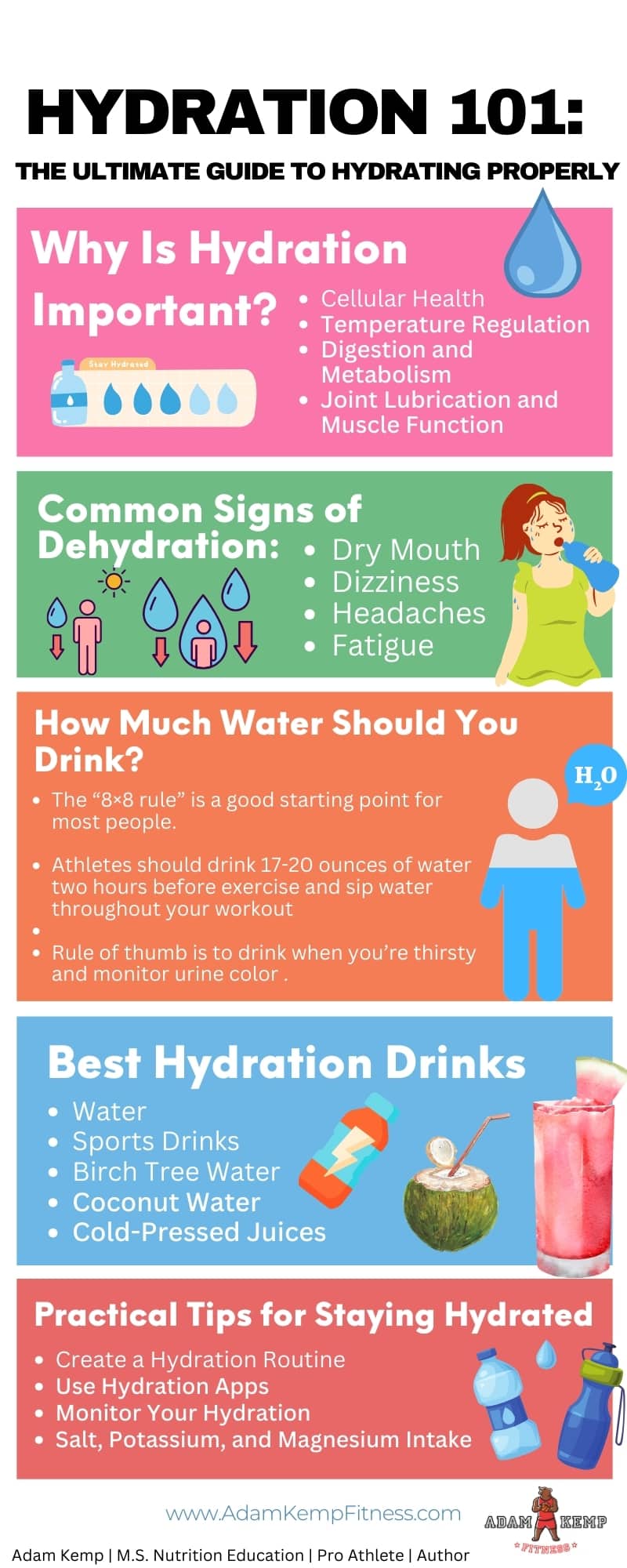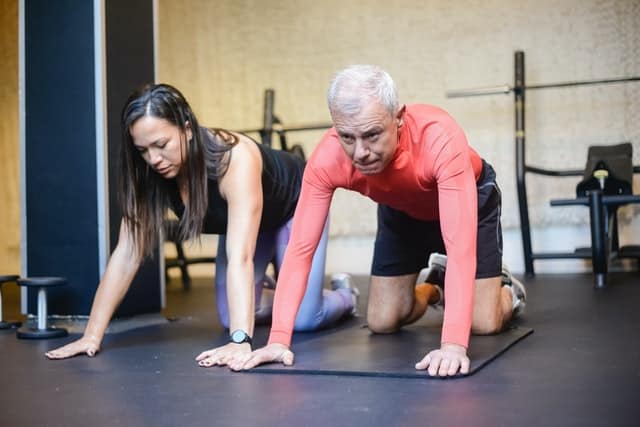How to Stay Healthy After 50: 10 Tips for Staying Healthy!
Staying healthy after 50 often requires more focus than in earlier years due to the natural aging process, which brings physical and metabolic changes.
As the body ages, shifts in muscle mass, bone density, and metabolism can impact overall health, making it essential to prioritize diet, exercise, and lifestyle choices.
These natural changes don’t mean vitality must decline; rather, they highlight the importance of a proactive approach to health and wellness.
For many, the ability to stay healthy after 50 comes down to maintaining consistency in healthy habits that address the specific needs of an aging body.
Muscle mass, for instance, may naturally decrease, but regular strength training and adequate protein intake can help prevent muscle loss and keep the body strong.
Likewise, staying mindful of bone health and cardiovascular well-being is essential, as these factors become increasingly significant in promoting a long, active life.
Many individuals around the world live fulfilling, healthy lives well into their 80s, 90s, and beyond, showing that age can indeed be embraced with the right approach.
By making small, thoughtful adjustments, it’s possible to retain energy, resilience, and physical capability well past 50, enabling people to enjoy life’s later years with vitality and a sense of purpose.
Addressing Common Health Concerns for People Over 50
- Metabolic Slowdown and Weight Gain: Many people experience a decrease in resting metabolic rate as they age, making weight management more challenging (Public Health Nutrition). This reduced metabolism requires a proactive approach to diet and exercise to prevent unintended weight gain.
- Bone Health and Osteoporosis: Bone density naturally decreases with age, especially in women post-menopause, which raises the risk of osteoporosis and fractures. Weight-bearing exercises, calcium-rich foods, and Vitamin D intake are crucial for maintaining bone health.
- Muscle Loss (Sarcopenia): Muscle loss accelerates after 50, impacting balance, strength, and metabolism. Resistance training and adequate protein intake help mitigate muscle atrophy and maintain functional fitness.
Best Ways to Stay Healthy After 50
As you enter your 50s, prioritizing your health becomes more important than ever. While aging can bring new challenges, it also offers the chance to adopt habits that support long-term well-being.
Here are some of the best ways to stay healthy after 50, from balanced nutrition and regular exercise to effective stress management and quality sleep.
These strategies will help you maintain vitality, prevent age-related issues, and continue enjoying an active, fulfilling life.
1.) Eat Enough Protein
Muscle loss, or sarcopenia, commonly accelerates around age 50, which can lead to a slower metabolism, reduced strength, and increased risk of falls or injury.
Consuming adequate, high-quality protein is essential for counteracting this muscle loss, as protein helps repair and rebuild muscle tissue, supporting physical strength, balance, and independence as you age.
For individuals over 50, maintaining muscle mass through protein intake has additional benefits: it stabilizes blood sugar levels, supports bone density, and enhances immune function.
Consuming protein throughout the day in meals and snacks keeps your metabolism active and provides a steady supply of amino acids for muscle repair and overall cellular health.
Good protein sources include lean options like chicken breast, grass-fed beef, eggs, and salmon.
Plant-based protein sources, such as lentils, quinoa, tofu, and chickpeas, are also excellent choices, especially as they’re lower in saturated fat, high in fiber, and contain antioxidants, all of which support heart health and help prevent chronic illnesses common with age.
2.) Stay Hydrated!

Staying hydrated is essential for people over 50, as proper hydration supports energy levels, joint health, digestion, and cognitive function.
Proper hydration also helps regulate appetite, preventing excessive calorie intake that can lead to weight gain, obesity, and related health issues.
While water is the best choice for hydration, low-calorie natural electrolyte drinks like Prime Hydration and Gatorade Fit can support hydration in several ways without adding too many calories to your diet.
You can check your hydration status by monitoring urine color: pale yellow is ideal.
Avoid excessive water intake, however, as overhydration can disrupt electrolyte balance and be harmful.
Besides water, other hydrating options offer additional health benefits.
Coffee, for example, contains antioxidants that may reduce the risk of Alzheimer’s disease and type 2 diabetes, while moderate caffeine can boost metabolism, supporting weight management.
Herbal teas, rich in antioxidants and other beneficial compounds, are another excellent option for promoting hydration, especially if you enjoy warm drinks.
Alcohol should be consumed in moderation.
Red wine, which contains heart-healthy polyphenols, is a preferable option if you choose to drink.
For overall health, aim to stay hydrated with a mix of beneficial drinks and prioritize water as your primary source.
3.) Use Supplements to Fill Nutrient Needs
Using supplements to support nutrient needs can be particularly beneficial after 50, as aging can affect nutrient absorption, muscle maintenance, and joint health.
A high-quality multivitamin tailored for older adults can help fill nutrient gaps, especially for vitamins D and B12, which are essential for energy, immune function, and bone health.
As bone density often decreases with age, particularly for post-menopausal women, vitamin D and calcium supplements can work together to strengthen bones and reduce fracture risks.
Magnesium also supports bone health and overall mineral balance in the body.
Protein supplements can aid in maintaining muscle mass, which tends to decline with age, leading to a slower metabolism and potential weight gain.
Whey or plant-based protein powders can be helpful for individuals who struggle to get enough protein through diet alone, and plant-protein powders like Garden of Life Protein and Greens also provide digestive help.
Last update on 2025-04-16 / This article includes affiliate links/Images via Amazon Product Advertising API. I may earn commissions on purchases made through these links.
Collagen supplements support joint health by enhancing cartilage elasticity and strength, and they may also promote skin health, providing added benefits as we age.
Colostrum is another beneficial supplement for immune support and gut health, as it contains growth factors and antibodies that aid in digestion and overall wellness.
Additionally, incorporating superfood supplements like Bloom Greens provides a range of antioxidants, vitamins, and minerals that support immunity, energy, and digestive health.
Last update on 2025-04-16 / This article includes affiliate links/Images via Amazon Product Advertising API. I may earn commissions on purchases made through these links.
These nutrient-dense superfoods can be particularly valuable for those with diets low in fruits and vegetables.
Regular use of these supplements, along with a balanced diet and active lifestyle, can make a noticeable difference in health, mobility, and energy levels after 50.
4.) Get Enough Physical Activity

Staying active is one of the most effective ways to maintain health and vitality after 50, supporting physical strength, mental well-being, and overall quality of life.
Physical activity encompasses more than just structured exercise; it includes NEAT, or non-exercise activity thermogenesis—those everyday movements like walking, gardening, household chores, and even standing up and stretching.
Increasing NEAT can help counteract a sedentary lifestyle, supporting weight management, cardiovascular health, and metabolic function.
Regular exercise is also essential.
Studies show that consistent physical activity can reduce the risk of heart disease, obesity, diabetes, stroke, and some cancers, while also boosting self-esteem, energy levels, and sleep quality.
Government guidelines recommend that adults get at least 150 minutes of moderate-intensity aerobic activity per week or about 30 minutes on most days.
For those new to exercise, starting small and gradually increasing activity levels can make this goal feel manageable and sustainable.
Before beginning any new or intense exercise program, consult your doctor to ensure safety, especially if you have any pre-existing conditions.
Medicare or other medical insurance may cover some activity-based wellness programs, and a supplemental policy could offer additional peace of mind if accidents or injuries occur.
You might even have a Medicare plan that pays for your gym membership!
Strength Training
Strength training and cardio are both crucial components of a well-rounded exercise regimen. Strength or resistance training is vital for countering the natural age-related decline in muscle mass and metabolic rate.
Research shows that progressive resistance exercises can lead to significant improvements in strength, muscle size, and metabolic health while also supporting long-term independence and daily function.
Weight training also plays a key role in bone density, reducing the risk of osteoporosis and fractures. Working with a personal trainer for a few sessions can help you establish a safe, effective routine and set achievable fitness goals.
Cardio
Cardiovascular exercises like walking, cycling, and swimming are excellent for heart health and joint-friendly.
Cardio workouts elevate mood, reduce anxiety and depression, and help maintain cardiovascular health, as they stimulate the release of endorphins, serotonin, dopamine, and testosterone—key hormones that promote mental and physical balance.
Low-impact activities like cycling and swimming are particularly beneficial for those with joint concerns, offering a gentle yet effective workout.
Adding high-intensity interval training (HIIT) for those who are already active can further improve cardiovascular health and provide anti-aging benefits.
Regardless of age or fitness level, there are accessible programs and community options available to support your journey.
While age brings natural changes, physical activity—whether through NEAT, strength training, or cardio—can help you remain strong, healthy, and resilient well into later years.
Balance Exercises
Falls can lead to serious injuries that impact mobility and daily activities, making balance training a critical component of staying healthy and independent after 50.
The risk of falls tends to increase with age due to changes in muscle strength, joint stability, and coordination, and the fear of falling can become a significant concern.
However, incorporating balance exercises into your routine can reduce fall risk, improve confidence, and help you maintain independence well into your later years.
Balance training doesn’t have to be complicated; simple exercises like standing on one leg, heel-to-toe walking, or using a BOSU ball can enhance coordination and stability.
Including balance exercises alongside strength training or other fitness routines helps build a more well-rounded fitness program that supports your ability to move with confidence and ease.
Whether you’re just starting or looking to enhance your stability further, balance training is an invaluable part of healthy aging.
5.) Control Stress
While many people envision a stress-free life after 55, reality often involves ongoing challenges, making it essential to learn how to manage stress effectively.
Understanding how to stay healthy after 50 involves recognizing the impact of stress on aging bodies.
Chronic stress can contribute to insomnia, high blood pressure, headaches, back pain, digestive issues, weakened immunity, and even an increased risk of diabetes.
Learning to manage stress not only protects physical health but also supports emotional well-being as we age.
To control stress, it’s essential to establish a routine that works for you, whether through prayer, meditation, reading, progressive muscle relaxation, or another calming activity.
Even simple breathing exercises can be powerful tools for relaxation.
Practicing mindful breathing a few times each day can help ease tension, promote better sleep, and prepare you for the day ahead.
This approach is particularly helpful for those seeking how to stay healthy after 50, as it’s accessible and can be done anywhere.
Morning breathing sessions can set a positive tone, while evening exercises may promote deeper, more restful sleep.
Apps like BreathWrk offer guided breathing exercises, making it easy to establish a consistent stress management routine that positively influences your health.
6.) Get Enough Sleep Each Night
As we age, achieving a restful night’s sleep can become more challenging, often due to changes in hormone levels, stress, or lifestyle shifts.
Yet, consistent, high-quality sleep is essential for physical and mental well-being, as well as immune system support.
Understanding how to stay healthy after 50 includes establishing a bedtime routine that encourages better sleep and addressing common sleep obstacles that arise with age.
Creating a bedtime routine can be as simple as reducing daytime naps, setting a consistent bedtime, and incorporating calming activities.
For instance, you might drink a cup of chamomile tea, practice three minutes of deep breathing, or do ten minutes of gentle foam rolling and mobility exercises to wind down.
These practices help relax the mind and body, signaling that it’s time for rest.
As a natural sleep aid, I love using Raw Botanics Rest, a supplement crafted with adaptogens and other natural ingredients to promote relaxation and ease into sleep.
If you’re hesitant about adaptogens for sleep, options like melatonin, magnesium, and zinc are excellent alternatives.
Melatonin helps regulate the sleep-wake cycle, while taking magnesium and zinc before bed is known to improve sleep quality and immune health.
Last update on 2025-04-16 / This article includes affiliate links/Images via Amazon Product Advertising API. I may earn commissions on purchases made through these links.
This combination can support relaxation and make falling asleep easier, even during periods of heightened stress.
Adding these natural sleep aids to your routine, alongside a consistent wind-down practice, can significantly improve sleep quality and length, contributing to better energy, mood, and overall health.
Getting enough restful sleep each night is not only rejuvenating but essential for staying healthy as you age.
7.) Remain Social
Social connections are essential for both mental and physical health, as isolation can lead to higher rates of illness and reduced happiness.
Staying connected with friends, family, or community groups provides joy, a sense of purpose, and keeps you engaged with the world.
While social environments may be more naturally accessible in younger years, retirement and lifestyle changes after 50 often require more intentional efforts to stay connected.
Options such as adult day programs, community centers, volunteer work, or hobby groups offer meaningful ways to interact with others daily.
However you choose to stay socially active, nurturing relationships and participating in social activities are key to staying healthy after 50.
8.) Maintain Your Oral Hygiene
Maintaining good oral hygiene is essential for overall health as you age, especially since there is such a strong connection between oral health and overall health.
Brushing twice a day and flossing daily are key habits to prevent plaque buildup, which can lead to gum disease.
Beyond impacting oral health, untreated gum disease has been linked to an increased risk of serious conditions, including stroke, diabetes, rheumatoid arthritis, and heart disease.
Regular check-ups with an oral health specialist can provide personalized guidance to keep your teeth and gums healthy, supporting both your smile and your long-term well-being.
9.) Take Care of Your Feet
Proper foot care becomes increasingly important as we age, as healthy feet are foundational for mobility, balance, and overall comfort.
Paying attention to foot health can prevent a range of issues, from joint pain to skin conditions, which can impact your daily quality of life.
Choosing well-fitted shoes that offer ample support and, if needed, orthopedic insoles can help reduce stress on your ankles, knees, hips, and lower back, making it easier to stay active without discomfort.
Beyond footwear, maintaining good foot hygiene is essential.
Changing socks daily can prevent common issues like athlete’s foot and fungal infections, which can be persistent if not managed.
Regularly inspecting your feet for cuts, blisters, or calluses and moisturizing to prevent dry, cracked skin also helps protect against infections and other complications.
Consider seeing a podiatrist for routine check-ups or if you experience persistent pain, as they can offer personalized advice and treatments to keep your feet—and you—healthy and mobile after 50.
10.) Mind Your Vitamin D Levels
People suffering from Vitamin D deficiency often don’t know it, and vitamin D deficiency could affect up to 50% of adults.
Vitamin D deficiency is associated with bone problems, cognitive impairment, and even cardiovascular disease, and maintaining vitamin D levels is an important part of staying healthy after 50.
Vitamin D levels are often low in people over 50 because the sun is the best source of vitamin D, and most people are not outside in the sun for adequate amounts of time each day.
Try to get outside in the sun, without sunscreen, for between 15 and 20 minutes every day for your Vitamin D needs. After these minutes, you should apply sunscreen consistently for the rest of the day.
Vitamin D is also found in food sources such as oily fish and eggs. Alternatively, you can talk to your doctor about Vitamin D supplementation.
Read Next: How to Stay Fit After 50 for Men






